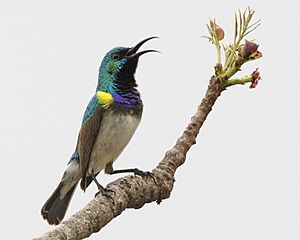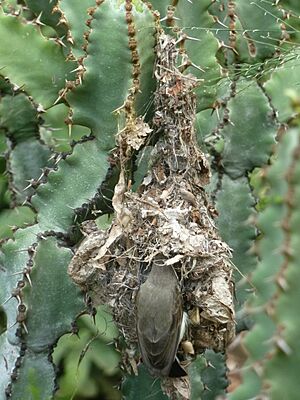White-bellied sunbird facts for kids
Quick facts for kids White-bellied sunbird |
|
|---|---|
 |
|
| Male bird singing | |
| Conservation status | |
| Scientific classification | |
| Genus: |
Cinnyris
|
| Species: |
talatala
|
| Synonyms | |
|
Nectarinia talatala |
|
The white-bellied sunbird (Cinnyris talatala) is a small, colorful bird. It is also called the white-breasted sunbird. This bird belongs to the Nectariniidae family, which includes many types of sunbirds.
You can find the white-bellied sunbird in many countries in Africa. These include Angola, Botswana, Democratic Republic of the Congo, Eswatini, Malawi, Mozambique, Namibia, South Africa, Tanzania, Zambia, and Zimbabwe.
Contents
Where Do White-Bellied Sunbirds Live?
White-bellied sunbirds live in a wide area of southern Africa. They are common in places like northern Namibia, Botswana, Zimbabwe, and South Africa.
These birds like to live in dry, open woodlands. They often choose areas with acacia trees or bushwillow trees. They also like thickets near rivers. Sometimes, they live in forests with Zambezi teak trees.
What Do White-Bellied Sunbirds Eat?
White-bellied sunbirds mainly eat nectar. Nectar is a sweet liquid found in flowers. They also eat small arthropods, which are tiny creatures like insects and spiders.
These birds often join other sunbirds to find food. They look for large groups of flowers with lots of nectar. In the late afternoon, they sometimes catch insects while flying. They also pick small bugs off leaves.
What Nectar Do They Drink?
White-bellied sunbirds drink nectar from many different plants. Some of their favorite plants include:
- Leonotis (wild dagga)
- Tecoma capensis (Cape honeysuckle)
- Aloe plants, like Krantz aloe
- Erythrina (coral-trees)
- Strelitzia
- Protea
- Kigelia africana (Sausage-tree)
- Kniphofia (torch lilies)
- Jacaranda trees
- Eucalyptus trees
What Arthropods Do They Eat?
Besides nectar, sunbirds also eat small creatures. These include:
- Insects
- Aphids
- Ants
- Grasshoppers
- Moths
- Spiders
How Do White-Bellied Sunbirds Reproduce?
The female white-bellied sunbird builds the nest all by herself. It takes her about 5 to 8 days. The nest is shaped like an oval and looks a bit messy. She uses dry grass and leaves, holding them together with spider webs.
The outside of the nest is decorated with small pieces of leaves and bark. Inside, it is soft and cozy. She lines it with plant fluff, and sometimes feathers or wool. The nest is usually attached to branches or thorns of a plant. They might even build it near a wasp nest for protection!
Egg Laying and Chicks
White-bellied sunbirds lay eggs from June to March. The busiest time for laying eggs is from September to December. A female bird usually lays 1 to 3 eggs.
Only the female bird sits on the eggs to keep them warm. This is called incubation. It takes about 13 to 14 days for the eggs to hatch. Once the chicks are born, the female still keeps them warm. Both parents help feed the baby birds.
The young birds leave the nest after about 14 to 15 days. But they often come back to sleep in the nest for another 4 to 14 days.
Are White-Bellied Sunbirds in Danger?
No, white-bellied sunbirds are not in danger. In fact, they seem to be doing well! They have even benefited from changes in their habitat in Zimbabwe.
Who Hunts White-Bellied Sunbirds?
Sometimes, these birds can become food for other animals. Some animals that hunt them include:
- Domestic cats (Felis catus)
- Slender mongooses (Galerella sanguinea)
Brood Parasites
Sometimes, another bird called the Klaas's cuckoo lays its eggs in the white-bellied sunbird's nest. This means the sunbird parents end up raising the cuckoo chick instead of their own. This is called brood parasitism.



